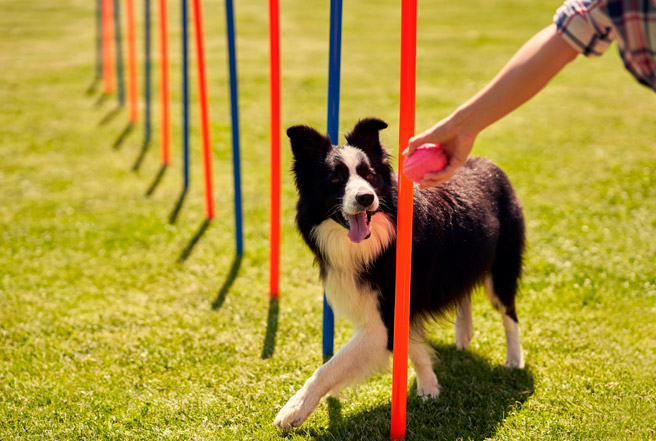“Why does my dog eat grass?”
It is not uncommon for dog owners to report their dogs eating grass. Indeed, my own dogs often spend large periods of time during our “relaxed” walks, grazing and apparently enjoying behaving like small spaniel-shaped ponies! However, many owners describe concerns that such grass eating is a sign of illness, digestive upset or a dietary lack of key nutrients. Indeed, for an animal that has extremely limited capacity to digest much plant material, it does appear unusual for dogs to eat grass. Unfortunately, that limited digestive capability often also means that any ingested grass leaves the body in much the same state that it entered. This can have embarrassing consequences for people and dogs as I’m sure many dog owners will agree!
Why is grass eaten?
It’s not that unusual for dogs to eat grass (or indeed other plant material). The dog has evolved as a scavenger and has clear omnivore tendencies. This means that dogs will eat a variety of foodstuffs, including meat and plant matter. Indeed, we now know that dogs have evolved the capability to effectively digest starch (1) and have genetic changes that shows key differences between them and wolves when it comes to how their bodies use and digest dietary fat and starch. In addition, dogs (but not cats!) have taste receptors on their tongue that can detect sweet tastes (2, 3, 4, 5). These factors, combined with the fact that fresh, growing grass is often rich in tasty sugars, give us some clues as to why dogs appear to enjoy consuming it!
Does eating grass mean my dog is ill or lacking something?
One of the most common queries that dog owners pose to trainers, vets and other dog professionals is whether eating grass is a sign of illness, or simply lacking something in their diet. While there have not been huge studies examining grass eating in dogs, the scientific work that has been done reveals no consistent link between illness or dietary deficiency and eating grass (6, 7).
In one study of grass eating, 68% of study dogs were recorded as eating plants either daily or weekly and of these dogs, grass was the most frequently eaten, by 79% (6). Illness prior to grass eating was apparent in 9% of dogs and vomiting afterwards in 22% (6). Interestingly, younger dogs were more likely to be recorded as eating plants (as many new puppy owners will agree I am sure!) but there was no other link to diet type, sex, spay/neuter status or breed (6). This observation is possibly linked to the natural exploratory behaviour of young dogs and where vomiting is observed post-plant eating, that is likely to be a simple digestive response to eating matter that is relatively indigestible, a not uncommon event in the domestic dog.
In a similar study, dogs were shown to be more likely to eat grass that was actively growing, rather than cut or in pots, and especially before their normal meal (7). In addition, the consumption of grass decreased as the day progressed (7), perhaps suggesting that grass is consumed when the dog is hungry, and it becomes a sweet tasting, opportunistic food source!
On this basis, for most domestic dogs, the eating of grass can be considered an entirely normal behaviour and is not necessarily indicative of digestive or other health problems. Indeed, it is likely that many dogs simply enjoy eating grass, especially fresh, sweet grass!
References
- Axelsson E, Ratnakumar A, Arendt M, Maqbool K, Webster M. Perloski M, Liberg O, Arnemo J, Hedhammar A, Lindblad-Toh K. (2013) The genomic signature of dog domestication reveals adaptation to a starch-rich diet. Nature. 495: 360-365
- Grace J, Russek M. (1968) The influence of previous experience on the taste behaviour of dogs toward sucrose and saccharin. Physiol Behav. 4:553–8
- Houpt KA, Coren B, Hintz HF, Hilderbrant JE. (1979) Effect of sex and reproductive status on sucrose preference, food intake, and body weight of dogs. J Am Vet Med Assoc. 174:1083–5.
- Ferrell F. (1984) Preference for sugars and non-nutritive sweeteners in young beagles. Neurosci Biobehav Rev. 8:199–203.
- Li X, Li W, Wang H, Bayley DL, Cao J, Reed DR, Bachmanov AA, Huang L, Legrand-Defretin V, Beauchamp GK, Brand JG. (2006) Cats lack a sweet taste receptor. The Journal of Nutrition, 136(7 Suppl): 1932S–1934S.
- Bjone SJ, Brown WY, Price IR. (2007) Grass eating patterns in the domestic dog, Canis familiaris. Recent Advances in Animal Nutrition in Australia, 16:45-49
- Sueda KLC, Hart BL, Cliff KD. (2008) Characterisation of plant eating in dogs. Applied Animal Behaviour Science, 111:120-132



